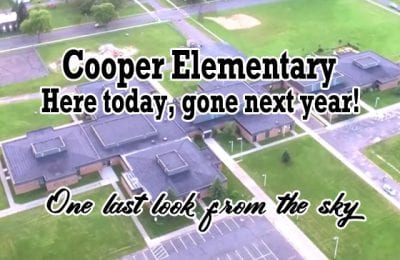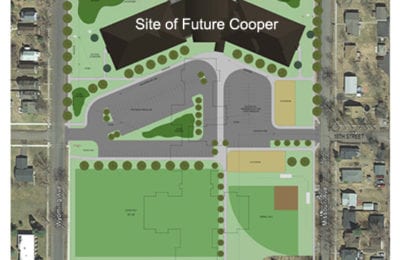Cooper School Opened in 1970 and Is Showing Its Age
By Gary Niemi
Whether or not the School District of Superior achieves its goal of passing a new referendum in April, one thing will not change. Cooper Elementary School is approaching its 50th birthday, and is showing its age.
The School District will host a public meeting tomorrow (February 2nd) at Superior Middle School that will address all aspects of the referendum. For more info about that meeting, please follow this LINK.
Cooper opened in 1970,with an “open concept” floor plan, a school design that was in vogue at the time. This decision has proven to be a challenge to work with as time has passed, teaching styles have evolved, and technology has advanced. In this article I hope to clearly explain some of the challenges and issues that we are faced in maintaining the Cooper facility.
(Note: The image above is of a concrete driveway at Cooper that was patched in Summer 2015. This is but one area where Cooper has exterior pavement problems.)
Shown below, this paragraph is a section of the exterior wall of the Weisberg wing of Cooper. Water in the masonry wall has caused the vertical staining and the bluish-tinged efflorescence that can be seen in this photograph. Construction methods in the late 60’s did not allow for water in these types of walls to be safely conveyed back to the exterior.

Educational Adequacy
When teaching children, the district must evaluate the adequacy of the spaces within which we educate children. As mentioned above, the open format popular in the 70’s poses its own peculiar challenges. Typically, classroom spaces are in a pod-type format.
The need for visual separation from neighboring classrooms, as a minimum, has driven the installation of bookshelf partitions. These are inadequate for noise separation. A typical classroom demonstrating this practice is shown below.

The picture below shows a common teaching space in the Weisberg wing at Cooper. The scarcity of storage results in multiple, different uses of this common educational space.

 Current educational standards as well as the SAGE Program drive the need to make-do with spaces that were not designed for the current use.
Current educational standards as well as the SAGE Program drive the need to make-do with spaces that were not designed for the current use.
On the right you see a storage area converted into an educational space. →

Space was adapted as a common pod storage area and break room
The picture on the left displays how a Pod storage room is also used to house student support areas.
This space was adapted as a common pod storage area and break room that is now also used for a student support office.
The room also contains a sink and counters that are not displayed in this photo.
Gymnasium & Cafeteria Do Double Duty
The gym and cafeteria at Cooper share the same space. What this means is that every day the gym must be transformed into a cafeteria for lunch. Then, after lunch the cafeteria must be converted back into a gym. This makes the space less than adequate for either use and is very labor intensive due to the need for staff to move cafeterias tables back and forth from storage every day.


Gym equipment & cafeteria tables share storage space. (©ExploreSuperior)
 Dishwashing area doubles as storage |
 Kitchen space is very cramped |

The site traffic flow creates many vehicle pedestrian conflicts and increases the accident potential.
Security & Safety
It is no secret that safety and security is a major concerns today due to security breeches and tragic events seen in other communities. The building and grounds layout of
Cooper Elementary create several safety and security issues.

Typical classroom exit doors at Cooper.
The traffic flow in and around Cooper creates many vehicle/pedestrian conflicts, and increases the chances of potential accidents occurring. The school footprint is sprawling – about 550 feet long. This causes real delays in responses to incidents occurring inside the building.
Additionally, almost every classroom has an exterior exit.
These pose both security and safety concerns. It is extremely difficult to monitor so many doors, and it is quite simple to over-ride a lock with something as simple as a piece of tape.

Aging fans, ducting, valves & piping at Cooper
Heating & Ventilation Challenges
Aging fans, ducting, valves & piping are an ongoing challenge at Cooper.
The mechanical rooms are in penthouses accessible via ladder only. This makes equipment maintenance & repair more difficult than necessary.
System controls. Controls for valves and dampers are original and do not allow optimization.
Cramped mechanical spaces add to the maintenance difficulties.
Roof Problems

There is a red arrow at every roof “blister” marked in this picture.
As buildings age, their roof blisters and leak happen. No amount of maintenance will prevent a roof from eventually leaking. This picture points out potential leak sites.

Water ponding on the roof of Cooper School
Leaks are caused by water getting between the roof plies. There are about 100 such trouble spots on Cooper’s roof. (There is a red arrow at every blister marked in this picture.)
Water ponding. How does water get in between the roof plies? In this case inadequate roof slope during construction lets the water pond on the roof. The lower pond surrounds a roof drain.
Inadequate Site Slope & Drainage
These images demonstrate what happens around the exterior of Cooper Elementary on a rainy day.
These three photos show how the water ponds next to the school.
Moisture is a major issue both inside and outside the school.
 |
 |
 |
Moisture Damage to Building Exterior
At Cooper after rainfall, moisture becomes trapped inside the walls. The picture below shows the patchy, discolored (dark) areas of the brick wall show that water is caught inside the wall construction.

The patchy, discolored (dark) areas of the brick wall show that water is caught inside the wall construction.

Spalling, caused by moisture freezing inside the brick, damaged this corner. We needed to cut out and replace the brick a few years ago.
Moisture breaks apart brick. Spalling, caused by moisture freezing inside the brick, damaged this corner. We needed to cut out and replace the brick a few years ago.

Water causes the brick to move different than the concrete foundation and a crack appears. Freeze thaw cycles assist this process. Control joints, properly placed during construction can prevent this from happening.
Moisture also moves walls. Water causes the brick to move different than the concrete foundation and a crack appears. Freeze thaw cycles assist this process. Control joints, properly placed during construction can prevent this from happening.
ACM (Asbestos Containing Material)
Asbestos is a hazardous material and is present in Cooper Elementary in the form of vinyl asbestos floor tile. White vinyl tile (containing no asbestos) has been used to patch areas where tan vinyl asbestos tile has cracked. Cooper is the only elementary school in the Superior School District that contains asbestos building materials. Such materials were permitted at the time this school was built.

A white vinyl tile (no asbestos) patch where tan vinyl asbestos tile had cracked. Cooper is the only elementary school in the District that contains asbestos building materials.

The pipe insulation at almost every elbow and tee in the heating system has asbestos.
Additionally, asbestos pipe insulation materials are used on the pipes of the heating system. Almost every elbow and tee in the heating system has asbestos pipe insulation. Asbestos in all of our schools that contain it is inspected every 6 months per environmental regulation and repaired if damaged.
Why Does Cooper Need to be Replaced?
As you can see, we deal with many issues at Cooper Elementary that are beyond repair. Despite ongoing scheduled and as needed repairs, this facility has many issues that make it an excellent candidate for replacement. To sum up, here is a list of issues that indicate that Cooper has outlived its usefulness, and cause me at Director of Buildings and Grounds for the School District to recommend that it be replaced.
- The building is at the end of its useful life.
- Multiple problems, concerns, issues, etc. are forcing this replacement.
- The building’s performance as a school is unacceptable and corrective repairs will not make it’s performance acceptable. We are stuck with an outdated floor plan and site.
- Unacceptable health, safety and security risks.
- Building components and equipment are technologically obsolete, and the cost to repair and maintain them grows out of proportion to their usefulness.
- Building systems are becoming unreliable and cannot be made reliable, economically. This poses a very real risk.
- Repair and maintenance costs exceed ½ the cost of a new school, and life cycle costs of a new building are much lower than those of the existing building.
- The building is not capable of effectively supporting current educational practices. Replacement will provide this capability while reducing operating costs.
- Student learning is adversely impacted every day by the current building’s condition.

Follow these links to read other stories on Explore Superior about facility issues in the School District:
Roof Maintenance at Schools
Maintenance Issues at High School
Why Does the Circle Need to be Replaced?




